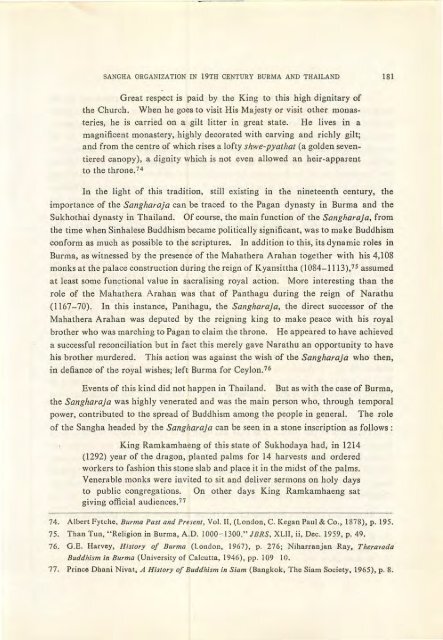The Journal of the Siam Society Vol. LXXII, Part 1-2, 1984 - Khamkoo
The Journal of the Siam Society Vol. LXXII, Part 1-2, 1984 - Khamkoo
The Journal of the Siam Society Vol. LXXII, Part 1-2, 1984 - Khamkoo
You also want an ePaper? Increase the reach of your titles
YUMPU automatically turns print PDFs into web optimized ePapers that Google loves.
SANGHA ORGANIZATION IN 19TH CENTURY BURMA AND THAILAND<br />
181<br />
Great respect is paid by <strong>the</strong> King to this high dignitary <strong>of</strong><br />
<strong>the</strong> Church. When he goes to visit His Majesty or visit o<strong>the</strong>r monasteries,<br />
he is carried on a gilt litter in great state. He lives in a<br />
magnificent monastery, highly decorated with carving and richly gilt;<br />
and from <strong>the</strong> centre <strong>of</strong> which rises a l<strong>of</strong>ty shwe-pyathat (a golden seventiered<br />
canopy), a dignity which is not even allowed an heir-apparent<br />
to <strong>the</strong> throne.74<br />
In <strong>the</strong> light <strong>of</strong> this tradition, still ex1stmg 10 <strong>the</strong> nineteenth century, <strong>the</strong><br />
importance <strong>of</strong> <strong>the</strong> Sangharaja can be traced to <strong>the</strong> Pagan dynasty in Burma and <strong>the</strong><br />
Sukhothai dynasty in Thailand. Of course, <strong>the</strong> main function <strong>of</strong> <strong>the</strong> Sangharaja, from<br />
<strong>the</strong> time when Sinhalese Buddhism became politically significant, was to make Buddhism<br />
conform as much as possible to <strong>the</strong> scriptures.<br />
In addition to this, its dynamic roles in<br />
Burma, as witnessed by <strong>the</strong> presence <strong>of</strong> <strong>the</strong> Maha<strong>the</strong>ra Araban toge<strong>the</strong>r with his 4,108<br />
monks at <strong>the</strong> palace construction during <strong>the</strong> reign <strong>of</strong> Kyansittha (1084-1113),75 assumed<br />
at least some functional value in sacralising royal action. More interesting than <strong>the</strong><br />
role <strong>of</strong> <strong>the</strong> Maha<strong>the</strong>ra Araban was that <strong>of</strong> Panthagu during <strong>the</strong> reign <strong>of</strong> Narathu<br />
(1167-70). In this instance, Panthagu, <strong>the</strong> Sangharaja, <strong>the</strong> direct successor <strong>of</strong> <strong>the</strong><br />
Maha<strong>the</strong>ra Araban was deputed by <strong>the</strong> reigning king to make peace with his royal<br />
bro<strong>the</strong>r who was marching to Pagan to claim <strong>the</strong> throne.<br />
He appeared to have achieved<br />
a successful reconciliation but in fact this merely gave Narathu an opportunity to have<br />
his bro<strong>the</strong>r murdered. This action was against <strong>the</strong> wish <strong>of</strong> <strong>the</strong> Sangharaja who <strong>the</strong>n,<br />
in defiance <strong>of</strong> <strong>the</strong> royal wishes; left Burma for Ceylon. 7 6<br />
Events <strong>of</strong> this kind did not happen in Thailand.<br />
But as with <strong>the</strong> case <strong>of</strong> Burma,<br />
<strong>the</strong> Sangharaja was highly venerated and was <strong>the</strong> main person who, through temporal<br />
power, contributed to <strong>the</strong> spread <strong>of</strong> Buddhism among <strong>the</strong> people in general.<br />
<strong>The</strong> role<br />
{)f <strong>the</strong> Sangha headed by <strong>the</strong> Sangharaja can be seen in a stone inscription as follows:<br />
King Ramkamhaeng <strong>of</strong> this state <strong>of</strong> Sukhodaya had, in 1214<br />
(1292) year <strong>of</strong> <strong>the</strong> dragon, planted palms for 14 harvests and ordered<br />
workers to fashion this stone slab and place it in <strong>the</strong> midst <strong>of</strong> <strong>the</strong> palms.<br />
Venerable monks were invited to sit and deliver sermons on holy days<br />
to public congregations. On o<strong>the</strong>r days King Ramkamhaeng sat<br />
giving <strong>of</strong>ficial audiences. 77<br />
74. Albert Fytche, Burma Past and Present, <strong>Vol</strong>. II, (london, C. Kegan Paul & Co., 1878), p. 195.<br />
75. Than Tun, "Religion in Burma, A.D. 1000- 1300," JBRS, XLII, ii, Dec. 1959, p . 49.<br />
76. G.E. Harvey, History <strong>of</strong> Burma (london, 1967), p. 276; Niharranjan Ray, <strong>The</strong>ravada<br />
Buddhism in Burma (University <strong>of</strong> Calcutta, 1946), pp. 109 10.<br />
"77. Prince Dhan i Nivat, A History <strong>of</strong> Buddhism in <strong>Siam</strong> (Bangkok, <strong>The</strong> <strong>Siam</strong> <strong>Society</strong>, 1965), p. 8.

















